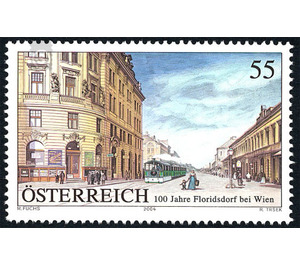100 years - Austria / II. Republic of Austria 2004 - 55 Euro Cent
Theme: Architecture
| Country | Austria / II. Republic of Austria |
| Issue Date | 2004 |
| Face Value | 55.00 |
| Edition Issued | 600,000 |
| Printing Type | combination printing |
| Stamp Type | Commemorative |
| Item Type | Stamp |
| Chronological Issue Number | 1837 |
| Chronological Chapter | OOS-OE2 |
| SID | 659990 |
| In 56 Wishlists | |
Today's Floridsdorf, the 21st district of Vienna with 44.46 m2, is an old cultural landscape. Already in the younger Stone Age (about 4000 to 2000 BC), the area was inhabited, as can be concluded from Steinbeil finds. About 500 BC Celts populated the area and the entire area north of the Danube, called by the Romans "Transdanubia", became a contested area of settlement only Germanic tribes, then nachragenden ethnic groups such as Lombards, Avars or Slavs. The settlement was initially called "Am Spitz" and belonged to the abbey Klosterneuburg. In 1786, Floridus Leeb, the then prelate of the monastery, distributed 30 grounds along Siedler's Schlosshoferstraße. After him, the place received its present name: "Floridsdorf". The originally rather agrarian place agrarian developed by Nordwestbahn, flourishing industrial plants and the steam tramway introduced in 1885 rapidly and 1894 raised to the city.1904 Floridsdorf was incorporated with the places Jedlesee, Großjedlersdorf, Donaufeld, Leopoldau, Kagran, Hirschstetten, Stadlau and Aspern to Vienna , Followed in 1910 Strebersdorf. In 1938, the parts Kagran, Stadlau, Hirschstetten, Aspern and the Lobau were incorporated into the newly formed 22nd district Donaustadt. In 1954 Stammersdorf came to Floridsdorf as part of a new demarcation. The Danube was vital at all times as an important trade route for Floridsdorf. The drawbacks of the raging river, with its countless ramifications and tributaries, were the annual heavy floods. In the years 1870 - 1875, the Danube was regulated for the first time, from 1972 to 1988, the flood protection was expanded again and so since Floridsdorf is protected from flooding, as well as the other lying on the Danube districts.


